
Culinary careers are sizzling again as the hospitality and restaurant industry bounces back from the pandemic and seeks to fill the positions vacated during the COVID-19 downturn. Chaffey College is doing its part to get more cooks in the kitchen.
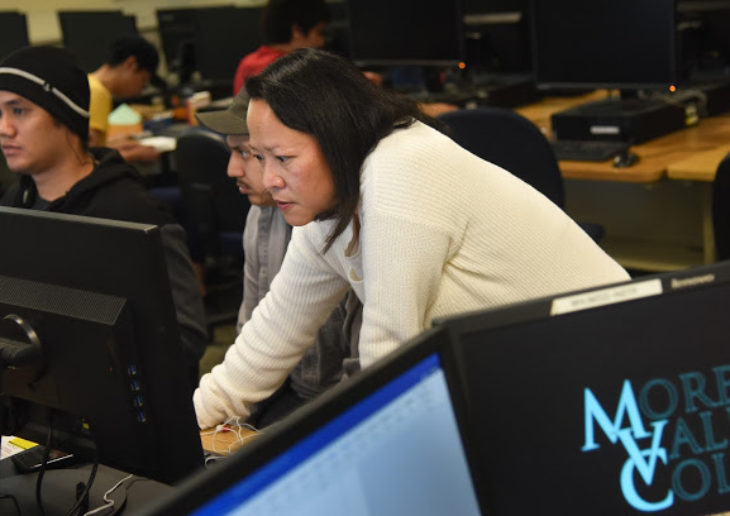
By Kris Lovekin / Inland Empire/Desert Regional Consortium
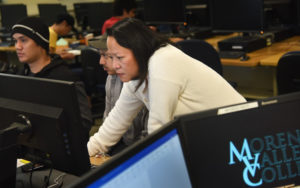
Moreno Valley – August 2018. Kasey Nguyen’s skill set is in high demand. She can explain the difference between a Raspberry Pi and a Beaglebone Black, both small computer operating systems that provide extra computer programming power at a low price. And she can, and does, teach people creative ways to use them.
An early adopter of computers, starting with a keyboarding class in high school on an Apple computer, she is a 40-year-old with a Ph.D. in cybersecurity, as well as experience in the computer industry.
She is also getting a lot of job satisfaction from teaching in the Computer Information Systems program at Moreno Valley College. “I love a challenge,” she said.
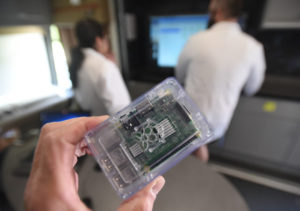
A raspberry Pi, a small processor that offers computing power at a low price. Photo by Kurt Miller
She works with students hungry for skills that will translate into jobs in cybersecurity, health information technology and especially, Virtual Reality.
“A lot of people don’t know what to do with that,” Nguyen said. “But it is augmented reality. It takes you to a different environment.”
She thinks it is a subject that deserves its own program. “I want that soon,” she said.
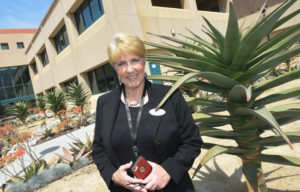 After that, she recommends that Moreno Valley College develop a certificate program in the administration of the “Internet of Things,” which sounds made up. But it is such a common term these days that you hear “I-O-T” abbreviated in radio commercials. For the uninitiated, it means that everything, including your refrigerator and your car, is built with embedded computers that can connect and talk to other computers.
After that, she recommends that Moreno Valley College develop a certificate program in the administration of the “Internet of Things,” which sounds made up. But it is such a common term these days that you hear “I-O-T” abbreviated in radio commercials. For the uninitiated, it means that everything, including your refrigerator and your car, is built with embedded computers that can connect and talk to other computers.
While students seem to be drawn to Virtual Reality and computer gaming, the computing programs cross all kinds of professions.
“I also drafted a course called Healthcare Security,” she said. “They have to be well rounded.”
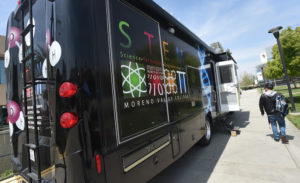 Nguyen moves quickly around a classroom, connecting equipment and pointing out the different tasks on the assignments for the week. “The way I teach is hands-on,” said Nguyen.
Nguyen moves quickly around a classroom, connecting equipment and pointing out the different tasks on the assignments for the week. “The way I teach is hands-on,” said Nguyen.
Career and Technical Education (CTE) programs based at California’s community colleges are in need of hands-on people, who can teach students very specific job skills that will transfer easily into the workplace in just two years.
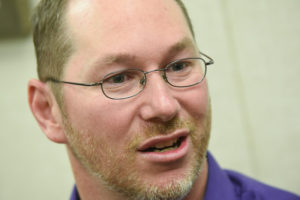 State lawmakers have invested in hands-on training. Three years ago they approved legislation that funnels $248 million each year into California’s 114 community colleges. Known as “Strong Workforce,” the money is designed to expand and enhance Career and Technical Education and align it with the needs of industry. Lawmakers see it as an efficient way to improve public education, retrain outsourced workers, and boost the state’s economy at the same time.
State lawmakers have invested in hands-on training. Three years ago they approved legislation that funnels $248 million each year into California’s 114 community colleges. Known as “Strong Workforce,” the money is designed to expand and enhance Career and Technical Education and align it with the needs of industry. Lawmakers see it as an efficient way to improve public education, retrain outsourced workers, and boost the state’s economy at the same time.
And it is working.
Moreno Valley College CTE Dean of Instruction Melody Graveen oversees a division with 26 specialized programs ranging from accounting to dental hygiene, to medical assisting. All of them rely on computer technology in one way or another.
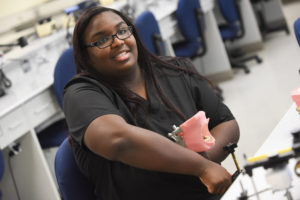 Graveen said it made sense to hire Nguyen with the Strong Workforce money to start a new program in the Computer Information Systems department. In addition, the college has money for equipment to outfit a mobile STEM laboratory for hands on computer demonstrations. “We can give students a chance to try it out,” she said. “Strong Workforce” has been hugely helpful in purchasing equipment. But Graveen has decided to invest a large chunk of it on new employees.
Graveen said it made sense to hire Nguyen with the Strong Workforce money to start a new program in the Computer Information Systems department. In addition, the college has money for equipment to outfit a mobile STEM laboratory for hands on computer demonstrations. “We can give students a chance to try it out,” she said. “Strong Workforce” has been hugely helpful in purchasing equipment. But Graveen has decided to invest a large chunk of it on new employees.
Nguyen has only been at Moreno Valley College since January of 2018, but in just a few months she has rewritten course curriculum, outfitted a mobile technology bus with computer screens and Raspberry Pi devices, and started planning for summer programs that will provide outreach to local schools.
Strong Workforce money also pays for a new marketing person to handle outreach through social media, as well as an employment placement coordinator who works on behalf of all the CTE students by developing relationships with employers, inviting employers to participate in advisory committees, and identifying internship and employment opportunities for students.
Jason Kennedy was hired in August, 2017 from Victor Valley College, and helps connect students to internships and jobs. He sets up industry advisory boards for each program and surveys students to see if the programs are successfully getting them into jobs.
“Moreno Valley has a great CTE Outcomes survey,” he said. “The goal is to have students get jobs at a living wage.”
He puts students through mock interviews and advises them on how to format their resume and portfolio for a job interview. He offers advice on professional attire and how to make a good first impression. “They’re shy sometimes,” he said. “They come in shorts and a t-shirt.”
He said the City of Moreno Valley is a good partner. He tours local manufacturing plants and makes contact with the Economic Development office, so he has the right contacts to make sure Moreno Valley College students get placed in internships.
He also presents at local high schools to tout the low cost and relatively quick return on investment for Moreno Valley College CTE programs. He also talks about how much help students receive in finding a job after graduation.
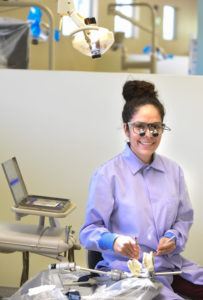 For instance, students in the dental assistant program have clinical rotations through three different offices: a general practitioner, an orthodontist and a dental surgeon. That variety helps students choose the area that best suits them. It also makes it likely that an employer has a chance to get to know them and offer them a permanent position.
For instance, students in the dental assistant program have clinical rotations through three different offices: a general practitioner, an orthodontist and a dental surgeon. That variety helps students choose the area that best suits them. It also makes it likely that an employer has a chance to get to know them and offer them a permanent position.
It is a popular program because it only takes 10 months. Dental assistants working full time can earn up to $37,000 per year for taking x-rays, mixing sealants and cement, and assisting at the chairside.
Desiree Pearson, 27, lives in Riverside. She signed up for dental assistant classes because she didn’t want other people to experience what she did. As a child, a visit to a dentist left one side of her tongue permanently numb. So she knows how important good dental care can be.
She said the consequences of not going to the dentist far outweigh anything that can happen to you in the dental chair. If you let your gums get infected, it can enter the bloodstream and impact your heart or other internal organs, she said.
Evelyn Ibarra-Leon, 27, said she comes from a family tradition of dentistry. Her mother was a dentist and Ibarra-Leon already holds a bachelor’s degree in biology from California State University San Bernardino. She applied, but did not get in, to the Loma Linda University School of Dentistry. She still hopes to be a dentist someday. The average salary is $158,000, and that is attractive.
But while she waits, she is going to take the training as a dental hygienist. She is in her first year of the two year program at MVC.
“That knowledge will help,” she said. “You can meld both worlds.” Dental hygienists earn $93,000 per year on average, according to the U.S. Bureau of Labor Statistics.
All of the clinical experience for the dental hygiene program happens right there on the MVC campus, because members of the public can come in for free dental checkups in offices that look very much like a typical dentist office.
Find out more about the Moreno Valley College dental clinic here: http://www.mvc.edu/academicprograms/dh/clinic.cfm
———————
Strong Workforce Program: To develop more workforce opportunity and lift low-wage workers into living-wage jobs, California took a bold step in 2016 to create one million more middle-skill workers. At the recommendation of the California Community College Board of Governors, the Governor and Legislature approved the Strong Workforce Program, adding a new annual recurring investment of over $200 million to spur career technical education (CTE) in the nation’s largest workforce development system of 114 colleges. For more information about Strong Workforce, please visit: http://doingwhatmatters.cccco.edu/StrongWorkforce/Overview.aspx.

Culinary careers are sizzling again as the hospitality and restaurant industry bounces back from the pandemic and seeks to fill the positions vacated during the COVID-19 downturn. Chaffey College is doing its part to get more cooks in the kitchen.
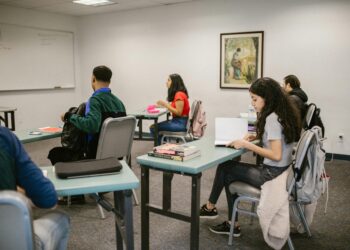
Dual Enrollment (DE) is catching on as students and their families recognize the advantages of earning college credit while still working towards high school graduation. But students aren’t the only… Read More – Good News for Community Colleges: Dual Enrollments Are on the Rise
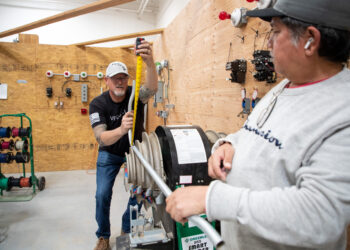
Enrollment in courses not offering credit toward a degree or certificate are outpacing for-credit programs in some states (Fed Communities). And it’s no wonder. With the convenience, minimal time commitment,… Read More – No Credit, No Problem: Noncredit Courses Gain Steam